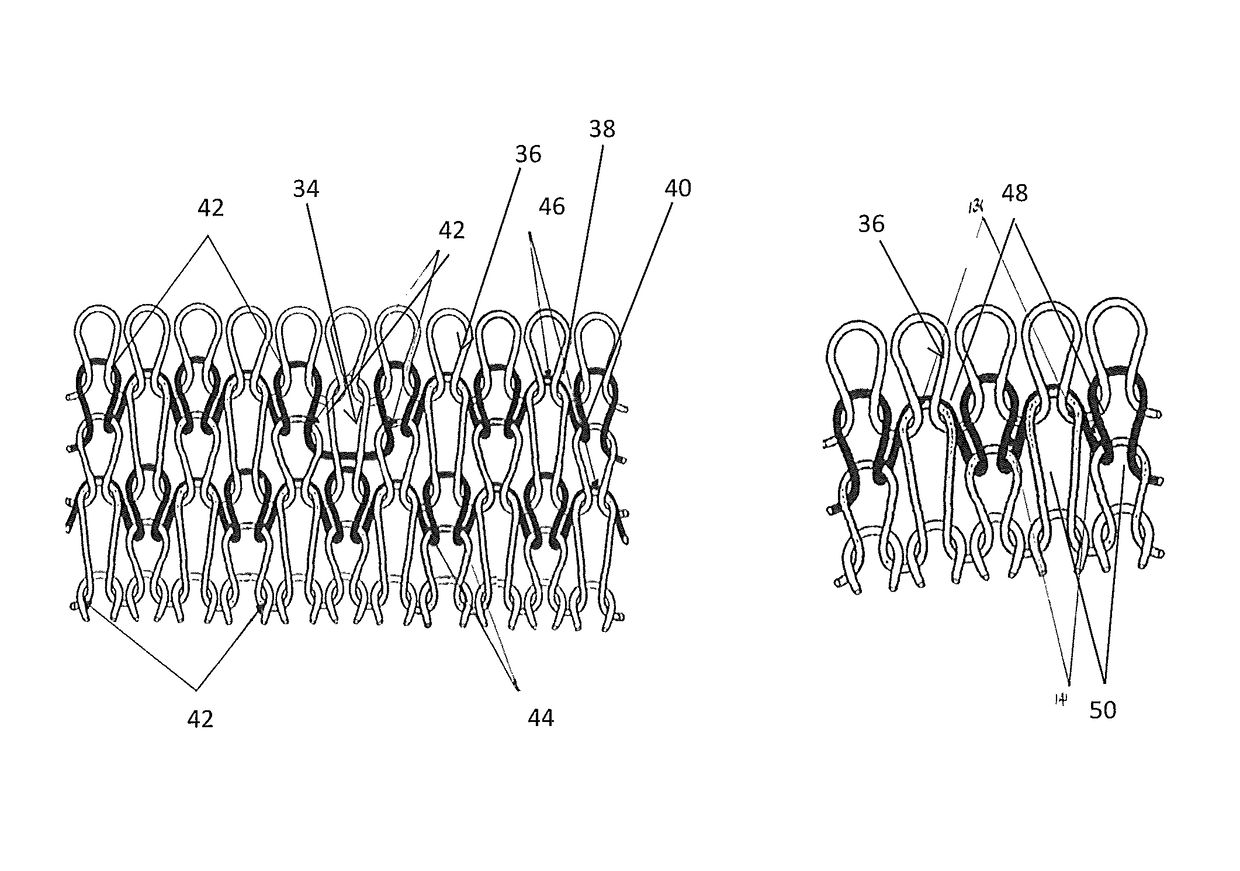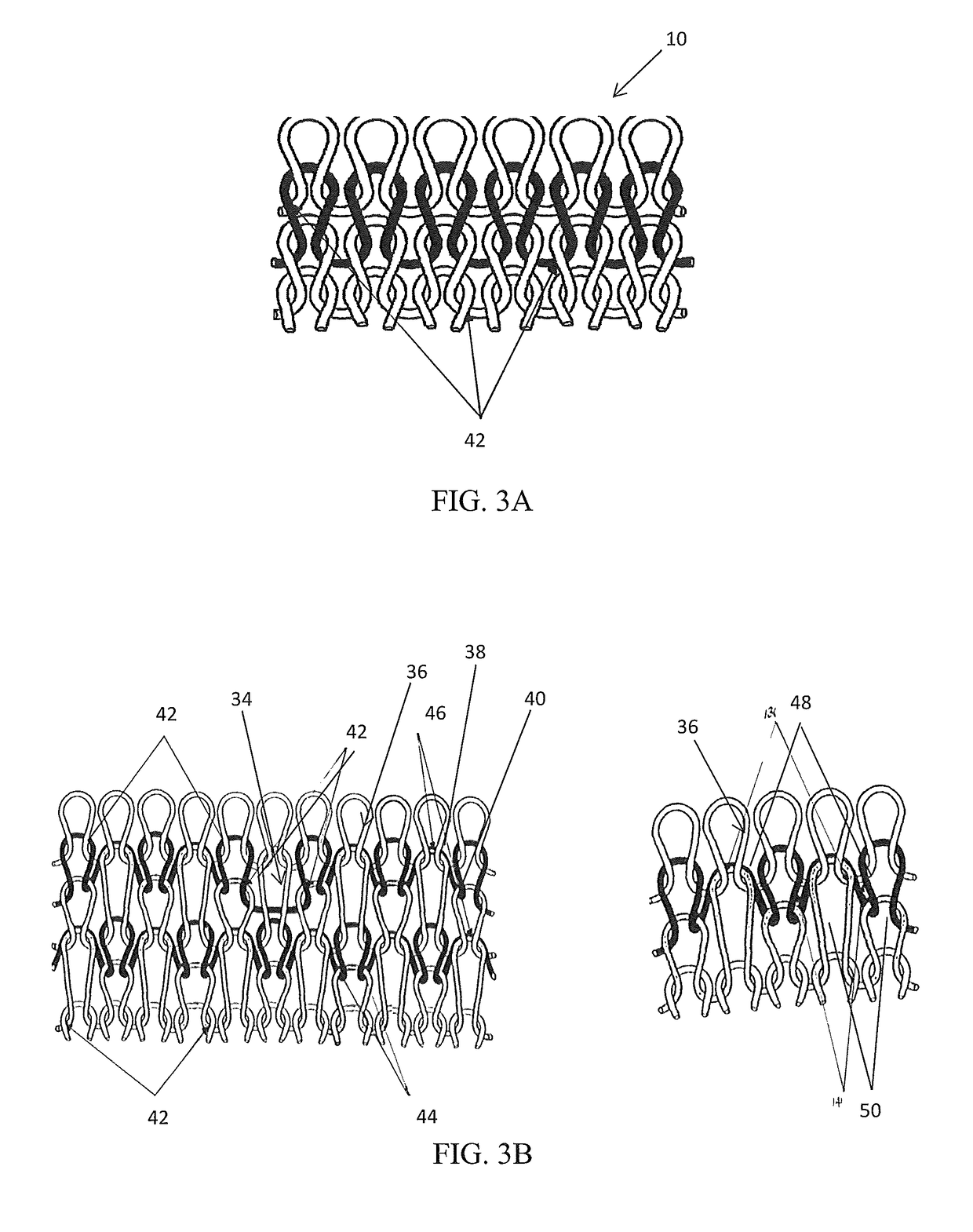Method for making electrically conductive textiles and textile sensor
a textile and sensor technology, applied in the field of making electrically conductive textiles and textile sensors, can solve the problems of increasing manufacturing costs, complex design processes, and inability to wear conductive fabrics against wearers' skins
- Summary
- Abstract
- Description
- Claims
- Application Information
AI Technical Summary
Benefits of technology
Problems solved by technology
Method used
Image
Examples
experiment a
[0104]In Experiment A, mean electrical resistivity (MER), fabric thickness, and optical porosity in the four different sample stitch patterns were compared to those variables in a single jersey 10 fabric. The results of Experiment A, discussed with reference to FIGS. 2, 5A, 5B, 5C, and 6, demonstrate how stitch patterns can be selected to affect these variables so as to optimize contact resistance in a textile.
[0105]The table in FIG. 2 shows mean electrical resistivity (MER) values in a single jersey (SJ) stitch pattern 10 control and in the four different sample stitch patterns. MER is shown for each stitch pattern having either relaxed or tensioned courses or relaxed or tensioned wales. Each of the four sample stitch patterns had significantly decreased MER in both the course (horizontal) direction 80 and wale (vertical) direction 74 in comparison to single jersey 10, both in relaxed states and in tensioned states. The discovery that each of the four sample stitch patterns had a s...
experiment b
[0114]In Experiment B, four fabric swatches, approximately 100 mm×100 mm in size, were knitted on a Shima Seiki WHOLEGARMENT™ 14gg knitting machine. “GG” represents “gauge” of a knitting machine, and corresponds to the number of needles / inch. The yarn in each sample swatch was a spun staple fiber yarn (80% PES / 20% INOX®), commercially available as “S-Shield” from Schoeller. Each swatch was knitted using a different percentage combination of plain jersey stitches 10, tuck stitches 36, and miss stitches 34 (stitch patterns SP-A, SP-B, SP-C, and SP-D).
[0115]Individual sample swatches were then placed under weights in a test-rig 60, as shown in FIG. 7. The test rig 60 was constructed using 3 mm thick polymethyl methacrylate. Two stainless steel weights 62 were used, one weighing 150 gm, the other weighing 250 gm. The weights 62 were separated from the sample swatches by a non-conducting cardboard layer. One weight 62 remained in placed on the sample being tested as a base weight to keep...
experiment c
[0120]In Experiment C, two fabric swatches, approximately 300 mm×100 mm in size, were knitted on a Shima Seiki WHOLEGARMENT™ 14gg knitting machine. The yarn in each sample swatch was a spun staple fiber yarn (80% PES / 20% INOX®), commercially available as “S-Shield” from Schoeller. Each swatch was knitted using a different percentage combination of plain jersey stitches 10, tuck stitches 36, and miss stitches 34 (stitch patterns SP-A and SP-B).
[0121]This experiment involved two human subjects. Subject 1 was female weighing 61 kg and subject 2 was male weighing 79 kg. Each subject stood, balanced only on her / his right foot, on the fabric swatches comprising the sample stitch patterns. Each subject wore a sock made from a non-conducting fiber. Each fabric swatch was tested for electrical resistance at two locations—at a line directly below the ankle and at a point approximating the ball of the foot). Resistance was measured on a Q-1559 multimeter (available from Dick Smith Electronics)...
PUM
 Login to View More
Login to View More Abstract
Description
Claims
Application Information
 Login to View More
Login to View More - R&D
- Intellectual Property
- Life Sciences
- Materials
- Tech Scout
- Unparalleled Data Quality
- Higher Quality Content
- 60% Fewer Hallucinations
Browse by: Latest US Patents, China's latest patents, Technical Efficacy Thesaurus, Application Domain, Technology Topic, Popular Technical Reports.
© 2025 PatSnap. All rights reserved.Legal|Privacy policy|Modern Slavery Act Transparency Statement|Sitemap|About US| Contact US: help@patsnap.com



